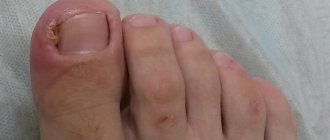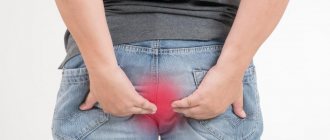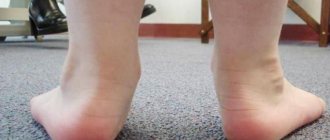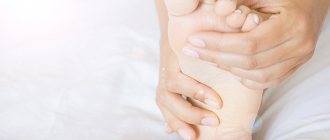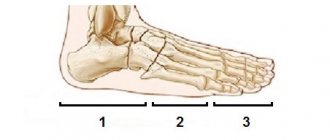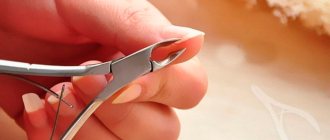In medicine, the condition, shape, color and size of the nail plates make it easier to diagnose a patient; these parameters can be used to identify internal disorders in the body and malfunctions in some life support subsystems. But thickening of the nails is not always a consequence of internal pathologies; often the cause of curvature, thickening, yellowing, formation of grooves and other external defects of the toenails is wearing tight shoes and illiterate care for them. The treatment of this problem will be discussed in the article.
Causes of thick toenails and what to do about it
Why do toenails thicken? In some cases, the nature of nail thickening is congenital. Compaction of the plate can be caused by:
- impaired blood flow in the fingers and fingertips;
- injury, bruise, inflammation of the nail bed;
- prolonged wearing of small, tight and/or closed shoes;
- fungal diseases;
- eczema;
- psoriasis;
- metabolic disorders;
- disruptions in the functioning of the endocrine and respiratory systems;
- avitaminosis;
- dysbacteriosis;
- rheumatism;
- neuropathy;
- flat feet.
The exact cause of the deformity must be determined by a specialist based on the tests obtained and the medical examination performed. The course and method of treatment, as well as accompanying recommendations, are established individually depending on what caused the pathology and the degree of its manifestation. This article will tell you which Revlon foundation for dry skin to choose.
Lack of proper care is the main cause of the problem. Read about the best thermal protection for hair here.
Paronychia
Paronychia
is a skin condition that causes redness and swelling around the nail. Over time, nails may become thick. A person may notice that their nails begin to peel. Paronychia most often develops in people who suck their fingers, when washing dishes, or when their nails are severely trimmed.
A number of occupations increase the risk of thickening nails:
- dishwasher;
- bartenders;
- laundry workers;
- cleaners;
- cooks;
- medical staff;
- fishermen.
Treatment methods
Among the known effective methods of eliminating the problem are medications aimed at combating fungal infections, as well as folk recipes that have an antimicrobial effect and soften the plate. Excellent quality + low price = Avon foundation.
Medication
If the deviation of the thickness of the plate from the norm is due to a fungal infection, the specialist will prescribe medication treatment in the form of ointments or tablets. An even tone without clogging pores - Vichy foundation.
The most popular of them:
- Terbinafine;
- Binafin;
- Terbizine;
- Mycomax;
- Orungal;
- Mikozoral et al.
The course and features of treatment are determined by a dermatologist. Treatment is usually carried out in conjunction with taking calcium and iron-containing medications and vitamin complexes.
Treatment of thick nails
Thick nails are not only possible, but also need to be treated. Otherwise, the nail may become seriously deformed and practically stop growing. For treatment with medications, you should consult a dermatologist. But there are many folk remedies. For example:
- In order to make a thick nail softer, you can use regular butter . To do this, soak a bandage in oil and wrap your fingers with thick nails in this mask. Place a fingertip on top and leave it on all night. To obtain results, an average of 5-10 procedures will be required.
- To combat fungus, propolis or Kalanchoe . The mask is applied to the affected nails at night and isolated from external contacts with a bandage.
In order for the treatment to be as effective as possible, you must first try to establish the cause of thickening of the nails and eliminate this cause. Take care of your health and your beauty! And may your marigolds always bring joy to you and those around you.
Author - Toropova Natalya
Website about hand and nail care Beauty-Hands.ru
Video
We offer you to watch a video with a few more recommendations for treating nail fungus at home
Thickening of the nail on the big toe is a common phenomenon, caused by various reasons, including age-related changes and fungus. The problem can be prevented by a set of preventive measures: follow the rules of hygiene, take herbal baths from time to time, and consume a sufficient amount of vitamins. You should also wear comfortable, well-ventilated shoes. The secret to the popularity of Bourgeois mascara is revealed in this article.
Stressful situation
The condition of the nails largely depends on the condition of the body as a whole. Stressful situations reduce immunity, worsen metabolic processes in the body and generally have a detrimental effect on our health. Therefore, nervous tension can both cause brittle nails and cause too thick nails.
Often, as a result of stressful situations, nails not only become very thick, but also become deformed - grooves and grooves appear on them. This is the first signal to reconsider your lifestyle and pay more attention to the state of your nervous system.
Poor nutrition
Poor nutrition, as well as stressful situations, cause a general imbalance in the body. If you have thick nails, pay attention to your diet - whether it contains enough vitamins and minerals.
Self-administration of vitamin preparations can also cause unnatural thickening of nails. Everyone knows about vitamin deficiency and its consequences, but hypervitaminosis is no less dangerous. Most often it occurs as a result of an excess of vitamins A and D in the body, which can cause intoxication and affect the condition of the nails.
Bath recipes
Now let's move on to the bath recipes. Perhaps one of these would be suitable:
- Squeeze two tablespoons of lemon juice into 5 liters of water and mix everything. Please note that lemon juice causes a burning sensation, so this bath can only be used in cases of diseases in which the skin on the foot and around the toes is not damaged.
- If problems with nails are a consequence of injury, then dilute celandine juice in water: you will need a tablespoon of juice for two liters of water. This product is very effective. But after it, the nails may turn orange-yellow for a short time. Don't worry, the normal color will return soon. It is also prohibited to use in cases of nail fungus. The fact is that the juice will penetrate deep into the affected nail and this will probably result in internal burns.
- If you need not only a nail softener, but also a disinfectant, then a bath with soap, not regular soap, but tar soap, is suitable. It is recommended to be used specifically for infectious lesions of the nail plate. You can find this soap in any pharmacy. It needs to be grated (always a coarse one). You will need about a quarter of the bar, which should be diluted in a small amount of water. For greater effect, you can even lubricate your nails with this solution before putting them in the water. Immediately after lubricating, wrap your nails for 10 minutes, and then proceed to the bath. During the procedure, do not forget to add hot water so as not to catch a cold.
Onychodystrophy (nail dystrophy) - symptoms and treatment
At the moment, there is no unified classification of onychodystrophies. Based on their origin, they can be divided into two groups:
- congenital onychodystrophy;
- acquired onychodystrophies.
Congenital onychodystrophies develop as a result of gene mutations and are inherited. The last group of diseases are in turn divided into:
- isolated onychodystrophy ;
- onychodystrophy, as part of other diseases.
Let's take a closer look at each group of diseases.
Isolated onychodystrophy
This subgroup of diseases includes: brittle nails, onychoschisis, Bo's furrows, onycholysis, onychogryphosis, leukonychia, the formation of longitudinal grooves and hyperpigmentation. Most often they develop as a result of ultraviolet irradiation, mechanical and chemical damage.
Brittle nails are the most common deformation of the nail plate. It is accompanied by breaking off the free edge of the nail with the destruction of all its layers. Occurs predominantly in women. The reasons for brittleness are frequent contact with hot water and abuse of manicure.
Onychoschisis is a transverse separation of the nail plate without signs of inflammation. With this disease, the nail grows correctly to the free edge, after which the nail plate splits into 2-3 layers. The most commonly affected nails are the index, middle and ring fingers. The reasons are repeated minor mechanical injuries, including improperly performed manicure, playing stringed musical instruments, etc.
Bo's groove (manicure onychodystrophy) is another common type of dystrophy. Characterized by the appearance of a transverse groove on the nail plate. It often forms on the nails of the thumb, index and middle fingers. The reason is a violation of the technique of removing gel polish using cutters.
Onycholysis is a common pathology in which the connection between the nail plate and the nail bed is broken. The separated part of the nail may take on a white-gray tint. The surface of the nail, as a rule, remains smooth, but if a fungal or bacterial infection is attached, the nail plate becomes uneven, rough and bumpy, thickened or brittle.
There are quite a few causes of onycholysis. These include:
- injury or compression of the nail;
- taking antibiotics such as tetracycline and fluoroquinolones;
- use of low-quality varnishes;
- avitaminosis;
- chronic dermatoses, diseases of the nervous, endocrine, digestive and cardiovascular systems;
- neurotic disorders (onychotillomania - the obsessive habit of destroying one's own nails using various devices, and onychophagia - the habit of biting nails and hangnails).
Onychogryphosis is a sharp thickening (hypertrophy) of the nail plate with the acquisition of a convex shape. As it grows, the affected nail begins to curl like a spiral or horn. The color of the nail plate becomes dirty yellow or brown.
The exact cause of onychogryphosis has not been established. The participation of external and internal factors is assumed. External triggers include various injuries to the nail apparatus, frostbite, wearing tight shoes, local infections and anhidrosis (impaired sweating). Internal triggers include diseases of the immune system (HIV), age-related endocrine disorders, chronic skin diseases, syphilis and varicose veins of the lower extremities.
Leukonychia is the most common form of nail pigmentation, in which white areas of various shapes and sizes are observed in the thickness of the nail plate.
There are three forms of this disease:
- dotted (spotted) or stripe-like (changed areas disappear as the nail grows);
- subtotal (partial damage to the plate);
- total (persistent damage to the entire nail).
Causes of the disease: use of low-quality nail polish, illiterate manicure and pedicure, frequent contact with household chemicals, wearing tight shoes, lack of microelements (iron, calcium, zinc) and vitamins A, E, C, D.
Longitudinal grooves are superficial, weakly expressed single or multiple lines on the nails. It is observed both in healthy people and in cases of matrix dysfunction. The reasons are a lack of zinc (mainly in vegetarians), careless manicure and abuse, cuticle or matrix injuries, decreased immunity and frequent stress.
Nail hyperpigmentation occurs when pigments such as hemosiderin and melanin accumulate. As a result, the nails acquire a yellow or brown tint. Depending on the cause, there are two types of hyperpigmentation:
- medicinal - after taking tetracycline and resorcinol;
- chemical - after prolonged use of manicure varnishes.
Onychodystrophy, as part of other diseases
Onychorrhexis is a longitudinal separation of the nail. This pathology is observed in chronic dermatoses, constant contact with chemicals and solutions that dry out the nail plate.
Scleronychia is a special form of nail hypertrophy. It is characterized by the hardness of the nail plate, complete loss of elasticity and transparency. Leads to separation of the nail graft from the bed, similar to onycholysis. The nail becomes yellow-brown and the lunula disappears. The cause of the disease is endocrine disorders.
Trachyonychia is a rather unusual form of dystrophy. The nail plate is characterized by the absence of a lunula and the presence of small thin scales with a dull nail color. This pathology occurs in immunodeficiency.
Thimble-shaped nail wear - pinpoint depressions and pits on the surface of the nail plate, resembling a thimble. Most often, this nail dystrophy occurs with psoriasis, exfoliative dermatitis, alopecia areata and lichen planus.
Onychodystrophy of the “roof slats” type is nail dystrophy in the form of shallow longitudinal ridges or grooves located in parallel. Occurs in lichen planus and senile atherosclerotic microangiopathy - atherosclerotic lesions of small blood vessels in elderly people.
Nail patterns - erasing of the free edge of the nail due to constant scratching of itchy lesions. The edge of the nail plate itself becomes somewhat concave. Such dystrophy occurs in chronic itchy dermatoses - neurodermatitis and eczema.
Hapalonychia is a rare form of onychodystrophy in which softening of the nail plate occurs. Such a nail easily bends and breaks off, and cracks form on the free edge. The cause of this pathology is a violation of sulfur metabolism during the formation of keratin in the nail.
Congenital onychodystrophy
Onychomadesis is the separation of the nail plate from the nail bed from the side of the ridges. The process occurs quite quickly and acutely, sometimes accompanied by pain and inflammation. Once matrix function is restored, a healthy nail plate grows. With relapses, atrophy of the nail bed may develop, which leads to complete loss of the nail. This type of onychodystrophy can be inherited and first appears after a finger injury.
Koilonychia is a saucer- or cup-shaped depression on the surface of the nail. The nail plates of the hands on the index and middle fingers are most often affected, but sometimes all nails are involved in the pathological process. The exact cause of the disease is unknown; the role of a hereditary factor is assumed. Cases of koilonychia occurring against the background of anemia, thyrotoxicosis, Cushing's disease, typhoid fever and other diseases have been recorded.
Anonychia is the congenital absence of one or more nails. This pathology is rare and is a hereditary anomaly. It can simultaneously occur with a violation of the structure of the hair, the functioning of the sweat and sebaceous glands and other developmental defects.
Platonychia is a flattening of the nail plate, the absence of its natural convexity. This type of dystrophy is quite rare and is an anomaly.
Micronychia are short nail plates on the fingers, less often on the toes. Can be inherited. Sometimes it is a sign of other diseases (for example psoriasis).
Hippocrates' nails are a genetic disease of the nail apparatus, characterized by convex nail plates that resemble “drumsticks.” The nails look rough, but they are also quite fragile. The exact cause of this pathology is unknown [1][4][5][7].
What to do to keep your nails healthy
Thickening of the toenail plates is an unpleasant problem that can occur to anyone. A few basic rules will help minimize the risk of its occurrence.
- Shoes should be selected according to size. It should not press or cause discomfort when walking.
- Under no circumstances should you borrow pedicure supplies from another person.
- In gyms, baths, and swimming pools, it is safer to use your own rubber slippers.
- Personal hygiene must be meticulous.
- For prevention, it is useful to use soda baths and make various compresses.
- Any wounds and injuries on the legs should be treated with an antiseptic.
- It is necessary to be attentive and careful about your health and nutrition.
Treatment of the disease
Sick nails are treated with an antimycotic spray.
If your toenails have become thick and the cause is a fungal infection, treatment involves the use of external and internal antifungal medications. Hard nail plates are treated with ointments, creams, varnishes, while simultaneously taking capsules and tablets of systemic antifungal action to achieve maximum effect. Traditional medicine in the form of baths and compresses will also help get rid of the signs of the disease.
Medications
Nail thickening due to fungus can be treated locally and systemically. Antifungal agents based on:
- azoles;
- allylamines.
Systemic medications for nail fungus are used in the form of capsules, tablets and solutions for intravenous injection. Popular means are summarized in the table:
| Name | Active substance |
| "Terbizil" | Terbinafine |
| "Exittern" | |
| "Lamisil" | |
| "Fungavis" | Ketoconazole |
| "Oronazole" | |
| "Nizoral" | |
| "Futsis" | Fluconazole |
| "Diafla" | |
| "Diflucan" | |
| "Irunin" | Itraconazole |
| "Kanditral" | |
| "Orungal" |
Local antifungal drugs are presented in the table:
| Name | Active substance |
| "Lamisil" | Terbinafine |
| "Terbinox" | |
| "Mikonorm" | |
| "Atifin" | |
| "Zalain" | Sertaconazole |
| "Mikospor" | Bifonazole |
| "Nizoral" | Ketoconazole |
| "Mycozoral" | |
| "Batrafen" | Cyclopiroxolamine |
| "Loceril" | Amorolfine |
Nailitis helps remove damaged areas of nails painlessly.
To improve the effect of topical antifungal drugs and remove thick nails, use a nail softener:
- "Nailitis";
- "Nogtemycin";
- Scholl.
If the deformation of the toenails is very severe, more than 4 fingers are affected by the fungus, and more than 50% of the horny covering of the finger is affected, doctors recommend surgical, laser, or hardware removal of the nail. This procedure speeds up drug treatment by removing the upper stratum corneum with a large amount of fungal mycelium.
Traditional methods
If the nail plates become thick due to fungus, it is useful to use recipes based on natural ingredients. Effective remedies in the fight against fungal diseases of the feet:
- Tar soap. Compresses and baths based on tar soap are useful if you have a fungal infection on your feet. To do this, tar soap is rubbed on a fine grater and applied to the affected area. To prepare a foot bath, dissolve soap in warm water (3-4 l).
- Vinegar. Apple cider vinegar lotions are good for treating hardened nail plates. Wine vinegar is also suitable for compresses. The procedure is done for half an hour. It is important to ensure that the product does not come into contact with healthy skin to avoid burns.
- Celandine. The juice of a recently collected plant should be applied directly to the affected area, avoiding contact with the skin around the nail plate. Keep the product for about half an hour, then wash off with plenty of water.
- Iodine. If your toenails are thick, it is useful to treat them once a day with iodine. It is important to use an individual cotton swab to treat each nail. Nail plates without signs of disease should also be lubricated for preventive purposes.
- Tea mushroom. A thin plate of kombucha, well attached for the whole night to the affected thick area, will help cure the fungus if done regularly.
- Salt. Foot steaming baths based on sea or regular table salt with the addition of soda and iodine are good for softening thick toenails. For 3 liters of water take 1 tbsp. l. salt and soda and 5 drops of iodine solution.
How to determine the cause of thickened nail plates?
The first signs that something is wrong with the nail plate are:
- peeling;
- itching between fingers;
- visible change in the color and structure of the nail;
- redness of the skin around and so on.
It is best to begin diagnosis and treatment immediately after thickening of the nails appears, because this can be a symptom of a rather serious disease.
First of all, pay a visit to a podiatrist and a dermatologist. Only a specialist will be able to say exactly why the thickening appeared.
The hospital will conduct an initial examination and check the thickness of the nail plate. Normally, it should be from 0.8 to 0.9 mm. If the indicator is at least 0.1 mm higher, then something is wrong with the plate. It is not worth solving the problem with cosmetic procedures yourself at home.
What problems does hardware cosmetology treat?
Therapeutic pedicure based on hardware cleaning is effective before applying medication to the damaged nail plate. Modern methods of treating diseased nails in cosmetology involve the use of a basic pedicure machine with different types of tools, ranging from blades and cutters to wire cutters.
Nail treatment occurs under the influence of a nozzle, which the device rotates. It is effective in the most advanced cases. Removing the damaged layer of the nail plate facilitates the penetration of antimycotic drugs into its structure.
Hardware cosmetology
The procedure is painless, which is an advantage of hardware nail treatment, which does not take much time. Cleaning with a pedicure device is not dangerous for patients diagnosed with diabetes, eczema or an allergic reaction. It increases the effectiveness of fungal treatment by almost 95%.
Indications
The method of hardware cleaning is effective in cases of onychomycosis, when it is necessary to remove the nail damaged by the fungus. The method improves the treatment of nail plates infected with fungus with various drugs, including ointments, varnishes or sprays.
It allows you to collect as much biological tissue as possible, ensuring an accurate diagnosis during laboratory tests.
The device has no side effects and is safe to use. The method allows you to prevent complications resulting from fungal infection. Hardware pedicure improves the appearance of damaged nail plates.
Contraindications
Various injuries to the skin of the feet or open wounds on the legs are contraindications for treatment using hardware. This universal method should be excluded in case of dermatoses or possible allergic reactions, as well as neoplasms.
Cleaning the nail plates using hardware is not recommended for pregnant women. The method is contraindicated for patients suffering from liver and kidney diseases. In any case, it is necessary to consult a specialist before using hardware cosmetology as a method of treating mycosis.
How the procedures are carried out, duration of treatment
Hardware cleaning of infected toenail plates is based on the use of a standard set of materials and a special composition for disinfection, ethanol and peroxide. The kit should include a drug that softens the nail plate. The procedure requires the use of special clothing by a healthcare worker.
From the inventory you need to take a foot bath, finger spreaders, and napkins. The choice of cleaning technique depends on the diagnosis.
A medical professional performing a pedicure procedure using a hardware method must perform the following steps step by step:
- Examine the foot and nail plates to diagnose the patient’s condition.
- Disinfect the skin of your toes and feet using the composition included in the kit.
- Treat the cuticle of each nail with a special oil to soften its structure.
- Immerse the patient's feet in an antiseptic composition to soften the skin.
- Treat the nail plates using a device and special attachments with cutters.
- Remove corns and calluses from the soles of your feet.
- Perform a foot peeling and scrubbing procedure.
After treating the nails and feet with the device, you can apply an antifungal agent and perform a special massage to improve blood circulation. Further treatment will depend on the patient's conscientious compliance with all instructions of the attending dermatologist. The cost of processing one finger using hardware is on average about 150 rubles.
Post-traumatic therapy
For a thickened nail, the cause of which is associated with a leg injury, it is important to reduce the load. If the injured area does not allow you to walk normally, it is better not to leave the house for several days. Otherwise, you need to apply a patch to the damaged nail and wear open-toed shoes. Recinol can be used to treat infected areas.
Recinol
The active component of the product has anti-inflammatory and anesthetic effects. Recinol restores tissue structures, which speeds up the healing process. An injured nail can be treated with medication, using ointment or gel. Troxevasin, heparin ointments, and arnica are suitable. Treatment of the nail plate should be performed several times a day for about a week.
Why it is impossible to treat changes in nail thickness using traditional methods
Traditional methods of treatment are often part of the treatment regimen for changes in nail thickness. However, you must first consult a specialist. Only a podologist can recommend a remedy that is right for you.
The independent use of traditional medicine methods will not solve the problem - after all, only a qualified specialist can determine its cause. In addition, an incorrectly selected remedy can aggravate the situation. In this case, it will be more difficult to solve the problem.
How to quickly soften thick and hard toenails of older people?
With age, nails lose their former beauty: they become wavy, harden, and acquire a dull yellow-white hue. This is especially noticeable in women before menopause. Approaching the 50-year mark, salts begin to accumulate, leading to thickening and roughening of the nails, so-called “bone nails” appear.
Diabetes mellitus in the elderly and other chronic diseases only aggravate pedicure procedures in this category of people. Here are some tips for softening nails in older people.
Foot bath with baking soda and liquid soap
Dissolve a teaspoon of soda and any liquid soap in water (37-38 degrees). Keep your feet in the solution for 10 minutes and dry. Treat the nails with clippers and shape the nails with a nail file. To prevent fungal diseases, it is recommended to treat your nails with tea tree oil and lubricate your feet with an emollient cream.
Aloe leaf for micro compress
Micro compress with aloe
- The procedure is best done at night
- Cut a piece of aloe leaf, wash it and cut along the leaf blade
- The inner side of the leaf with mucus is applied to a hard nail. Fix the aloe with a piece of cellophane film and a bandage; you can use an adhesive plaster for convenience. If it is necessary to soften several nails, this procedure should be carried out with each nail.
- The next morning, remove the compress. If necessary, trim your nails. Now it will be easy to do
Kombucha compress
A piece of kombucha is applied to the problematic nail. Cover with polyethylene and secure with a bandage. After 6-8 hours, remove the compress.
Folk remedy for softening rough skin of feet and nails, video
Onychomycosis is a fungal disease of the toenails
How to prevent fungus?
Taking vitamins will keep the immune system in good condition.
To avoid having to contact a dermatologist with complaints about thickening and changes in the appearance of the nail plate, it is important to prevent all possibilities of fungal infection. If you take care of your own health, prevent a decrease in immunity, keep the amount of hemoglobin in the blood at a sufficient level, take vitamins and microelements, avoiding vitamin deficiencies, you can protect yourself from fungal infections.
To prevent foot fungus from occurring, you need to wear only your own clothes and shoes, and never walk barefoot in public places with high humidity. It is important to choose boots from breathable materials and only in size, especially if your feet sweat excessively. All wounds and calluses on the feet must be treated immediately, preventing infection from entering the bloodstream.

